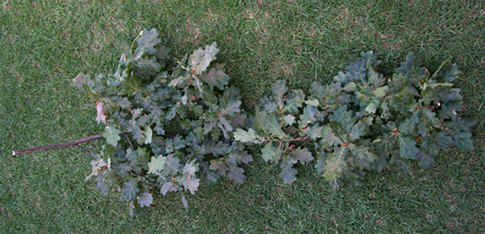Badnjak
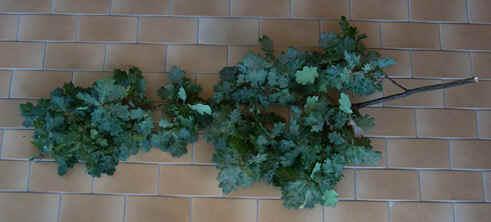
Serbian households in their warm and entertaining manner hold a special affection for the heralding of Christ's birth, Who
manifested Himself as Emmanuel” God is with us" - the Son of God born in the flesh of a Virgin Mother.
Of the numerous religious and culturally rich traditions, perhaps the most endeared is that which surrounds the
badnjak-the Yule
tree-log. The badnjak, as it is called in Serbian, is a specially selected young oak tree which has retained its foliage throughout the
winter months. Also, being a hard wood, it produces a tremendous amount of light and heat when burned. The choice of exactly
such a tree is important, in that is represents the "death of inter" teaming inside with newness and the warmth of life. Christ was
born in Bethlehem, into a sleeping world, frozen over with death and decay, waiting its rebirth in the newness of Life. For Christ is
Life itself.
By entering into the reality of this new life, the badnjak acquires its spiritual imagery as the "tree of life," upon which Our Lord
was crucified. As the image or icon of the Tree of Life, the badnjak prefigures the "kenosis" or self-emptying of Christ on the
Cross, in the same way as does the icon proper of the Nativity. For the swaddling clothes of the infant Christ child prefigure his
winding sheet, and the manger in the cave, his tomb.
Through the sprinkling of Holy Water, the invocation of the Most Holy Trinity is
bestowed on the badnjak, praying that this tree be
given the same effectual operation as the wood of the Cross: a source of spiritual strength by which the enemies of God are
destroyed and the powers of darkness are overcome by the light of Christ, the "Sun of Righteousness."
The Eve of the Nativity begins very early with an envigored morning in the snow. The male members of the household fell and
bring the young oak to the foyer of the home. There the lower, heavier portions of the trunk are split into three logs - each referred
to as a badnjak. The upper, foliaged portions of the tree are decorated by delighted children with all sorts of fruits, nuts and
candies. All of this is finally surmounted with red, blue, and white ribbons. Finished with uncompromised satisfaction, the best fruits
of the harvest and the fullness of the Serbian national colors adorn the "Tree of
Happiness," as it is greeted in Serbian - Badnjache Veseljache.
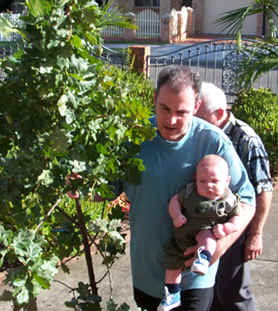
Now in full array, the badnjak is brought into the home by the "badnjichari” its bearers, and with exchanged greetings is presented
to the "domachin," or the host, who will bless the embellished badnjak. The paraliturgical rite which is to follow is greatly
reminiscent of the "Litiya" service of the Orthodox Church, in which bread, wheat, wine and oil are blessed and distributed for the
sanctification of those partaking of them. These prayers, as an act of "consecration," in the Church are a source of revelation, for
they reveal the matter of this world as a source of "communion" with the Living God.
Taking a handful of wheat, the "domachin" sprinkles the tree in the Name of the Father, Son, and Holy Spirit. In exchange for the
sacrifice of the material harvest of grain, our bodily staff of life, a petition is made seeking in return a prosperous and bountiful
year. For it is of the wheat that bread is made, which in turn always is the image of the pure Body of Our Lord.
Next, the "domachin" blesses the badnjak by pouring wine over it in the Name of the Father, Son, and Holy Spirit. He asks that the
presentation of the harvest of the fruits of the vine may grant unto his family fortune, peace and all of God's blessings. This act
points to the crucifixion of Christ, in which His Blood was spilt from His pierced side. It is as with the Centurion
Longinus, our
witness to the Divinity of Christ. For all wine is the prototype of His precious Blood.
Thirdly, the "domachin" anoints the "Tree of Happiness" with oil in the Name of the Holy Trinity. He seeks in return health in the
home and prosperity for the members of the household in every step of their lives. The term for oil in Greek is
"eleion," which may
be interpreted as mercy, light, grace, the spiritual symbols of forgiveness, healing and baptism, filled with the gift of the Holy Spirit.
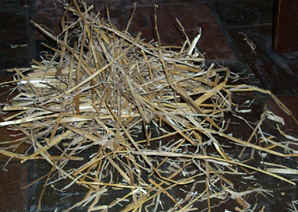
Positioning the tree in its proper place, straw is then strewn by the children under the tree, beneath a well - laden lenten table, and
as well in other parts of the home. Decorated in this manner, the home represents the manger in which the Divine Child was born.
The three badnjak logs are then placed in the hearth to kindle the Yule fire, adding greater warmth to the Feast of the Nativity of
the Lord.
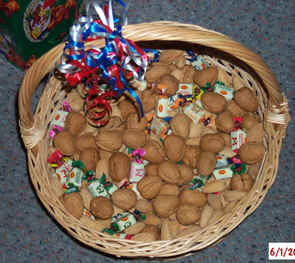
Lastly, four walnuts are tossed in cruciform, invoking the Name of the Father, Son, and Holy Spirit, followed by the singing of
"Glory to God in the Highest and on Earth Peace, Good Will Towards Men." This is then the summation of all Christian prayer and
hope, to glorify God and to bring Peace to men. For Christ is Peace Incarnate.
Much the same takes place in Serbian Orthodox Churches, where the faithful assemble as one in the new-born Lord. As a
community they gather to bring in and bless the badnjak heralding the Incarnation of Emmanuel-the Son of God born in the flesh of
a Virgin Mother.
